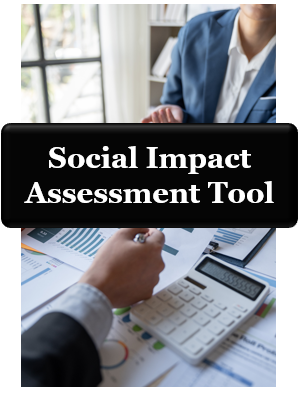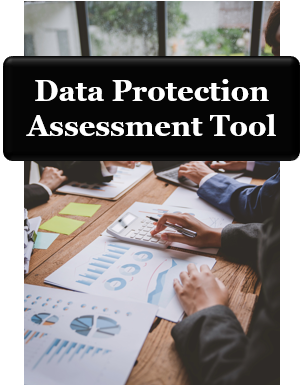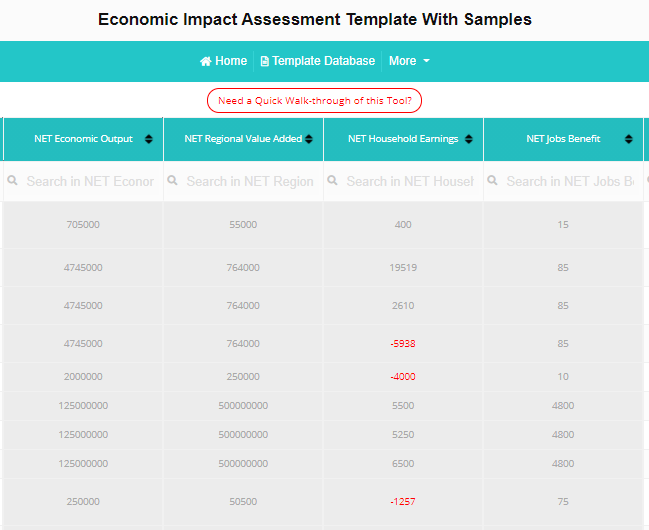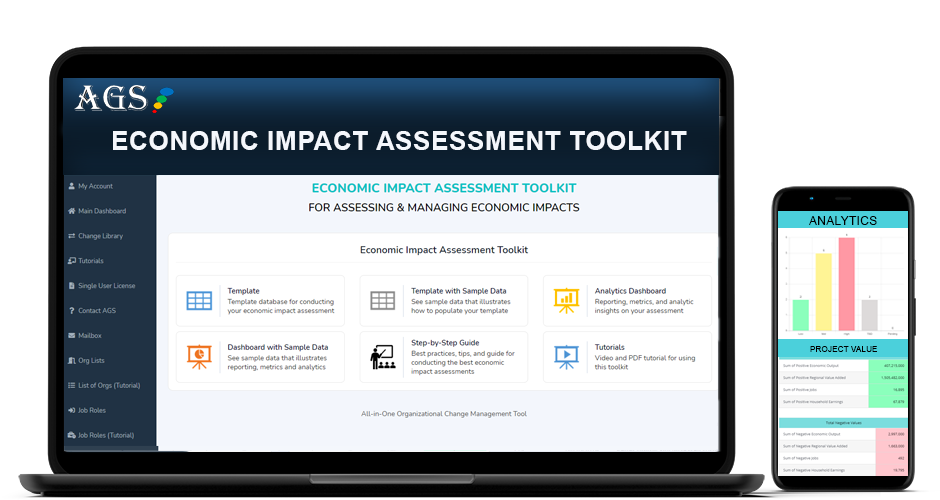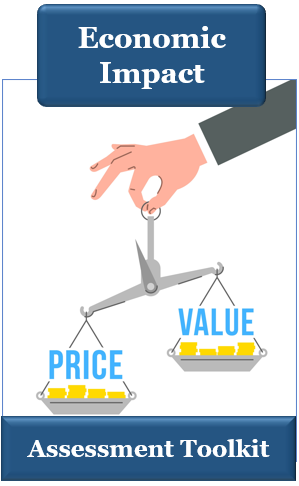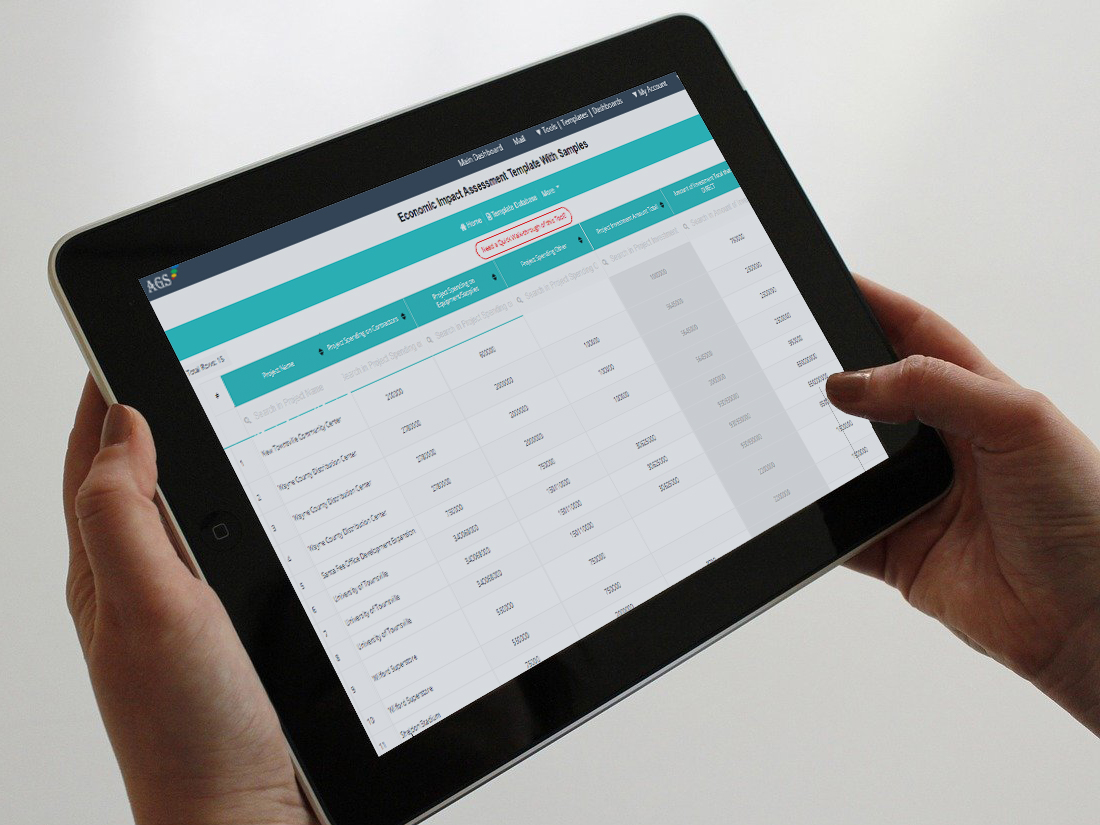COMPLETE GUIDE TO THE BEST ECONOMIC IMPACT ANALYSIS
The Best Guide for Conducting an Economic Impact Assessment (Samples and Templates)
When a project, program, or policy is going to have a monetary impact on a specific geographical area, industry, or group, an economic impact analysis is performed as part of the project assessment.
The economic assessment is an important tool that provides insights into impacts on things like jobs, revenue in the region, and overall profits. It can also provide a goal by which to measure the success of a project, such as the opening of a new distribution center or expansion of a subway route.
Doing an economic impact study involves looking at both the direct and indirect effects of an activity on several economic levels, both positive and negative. To do this accurately requires multiple economic impacts data points and the use of economic analysis methods and models.

Guide for Conducting an Economic Impact Analysis
As you can imagine, trying to estimate a project’s impact on the economy and jobs without having an economic impact assessment template to use would be very difficult.
A template helps define economic impact with a framework and the steps taken to complete an economic assessment. It guides those performing the analysis through the process, so they gather the appropriate data needed for an accurate economic impact study.
We’ll dive deeper into how to conduct an assessment of economic impacts in this AGS article. You’ll also find answers to, “What is the economic impact?”, “How do you do an economic impact study?”, and “Where can I find an economic impact assessment template?”
What is Economic Impact?
The economic impact is the financial effect that an event, program, project, or policy has on an entity. That entity could be a person, a neighborhood, a city, an industry, or an entire country.
Let’s look at a few uses of the term to get a better idea of the economic impact definition:
- The reduced price of gasoline had a positive economic impact on the Jones family due to their long commutes each day.
- The new Walmart store had a positive impact on the economy in the town as a whole due to the new jobs it created, but a negative economic impact on nearby small businesses.
Economic Impact Definition
How do you define economic impact as it relates to a project? It’s the impact that a project may have on things like business revenue, business profits, job creation, and wages.
When looking at the answer to, “What is the economic impact?”, you have to consider any type of financial benefit or detriment that a project may have on a community or industry.
Does it offer a revenue benefit for local suppliers? Will it bring in tourism dollars for hotels and restaurants? Is the average wage level of the area going to increase or decrease?
Your economic impact definition is basically going to include any type of impact from a financial point of view on the entity being analyzed (community, town, industry, etc.).
What is an Economic Analysis?
An economic analysis, also called an economic assessment, is a study of the impact on the economy for any type of project, event, program, or policy change.
For example, a recent economic assessment that’s been done could be the economic impact of the global pandemic as it relates to the loss of business revenue. Some industries, such as the tourism industry, define the economic impact of the pandemic as a significant loss of revenue.
But for others, such as technology providers like Zoom, the economic impacts have been the opposite, with the use of video meetings increasing, thus causing a positive impact through higher revenue.
What is the economic impact looking at?
You should include both the positive and negative impacts on the economy from a project, not just the positive ones, so you end up with a realistic overall economic impact analysis.
There are typically three key types of economic impacts being analyzed when doing an economic impact study. When you review an economic impact definition just about anywhere, you’ll see the terms:
- Direct Impacts
- Indirect Impacts
- Induced Impacts
When using economic analysis methods to do an economic assessment, it’s important to know how each of these three types of impacts is defined.
Direct Economic Impacts
Direct economic impacts would be the employment and income generated directly by a project.
For example, if you were building a new distribution center in a city, you would need to hire labor, buy materials from suppliers, and contract services for technology infrastructure.
The income that generates for the businesses and contractors you work with would be counted as a direct economic impact.
Indirect Economic Impacts
The indirect impacts used for an economic impact analysis would include employment and income generated through secondary sources.
For example, if you’ve hired a technology firm to add an IT infrastructure to your new distribution center, the money you pay that firm is a direct impact. But when that firm buys IT hardware from a supplier to fulfill the project, the revenue the supplier generates from the purchase is considered an indirect economic impact.
Induced Economic Impacts
The spending that is a result of income generated from direct and indirect economic impacts is considered induced economic impacts.
An example of this would be the increased spending on consumer products, entertainment, food, etc. by employees that found themselves with more disposable income as a result of getting a job due to the new distribution center project.
Induced economic impacts are one of the more difficult variables to estimate when doing economic impact analysis.
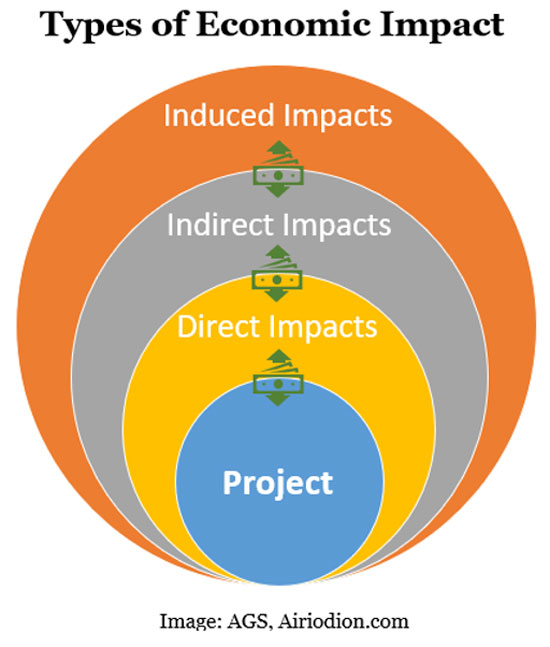
Why Define Economic Impact for a Project?
Any project that is going to make an impact on a region or industry can benefit from having an economic impact analysis performed. Even internal projects for large companies will typically have an economic impact study.
When you define economic impact at the beginning of a project, it can inform project decisions to ensure a more profitable and productive outcome.
Here are some of the reasons to do an economic impact analysis:
- Decide on resource allocation
- Understand the financial impacts of a change
- Long-term planning
- Express the benefits of a project to those being impacted
- Understand the benefits or drawbacks of an expansion
- Back up conceptual ideas with facts and figures
How Do You Measure the Economic Impact of a Project?
Part of how you define economic impact is to understand what factors of financial impacts you’re going to be analyzing. You’ll want to be sure that any economic impact assessment template you use accounts for four key measurement areas.
An economic impact assessment measures:
- Economic output
- Regional value-added
- Jobs
- Household earnings
Example of Inputs in AGS’ Economic Impact Assessment Tool
When you input positive and negative economic impact assessment measurements, the AGS Economic Impact Tool will auto-calculate the net values for you!
Economic Output
The economic output of a project may also be referred to as business revenue for the businesses supplying products or services for the project.
For example, the economic output includes all materials, labor, and services needed to fulfill a project, thus they would mean positive economic impacts on those supplying those items.
When building a distribution warehouse, you would need construction materials, temporary labor, and other items that would mean sales revenue for local suppliers of those items.
The revenue generated for businesses from those project purchases would be included in your economic output when doing an economic impact study.
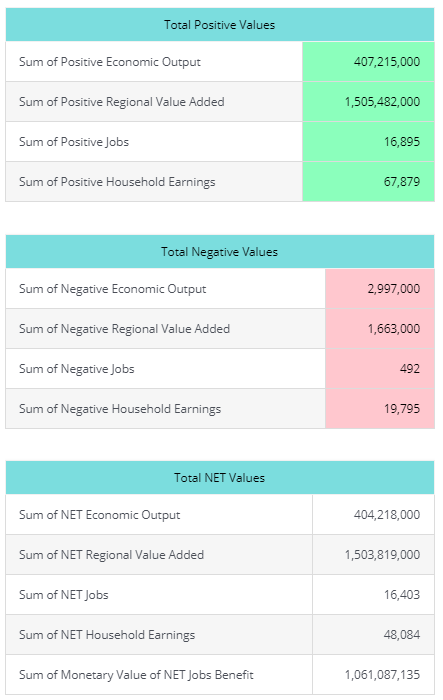
Example of positive, negative, and NET values reporting in our Economic Impact Assessment Toolkit
Regional Value Added
The economic impact definition of a regional value-added measurement is an estimate of the impact on the gross regional product for the geographical area that you’re assessing.
A regional value-added for the expansion of a museum could be the overall estimated increase in tourism dollars it would bring to the region.
You could also express regional value added as the overall benefit to the population, for example, if you were building a new hospital in a city that had none, there would be a value added in terms of more expedient healthcare.
The things you include in the regional value added category will depend heavily on the type of project or event that is being assessed using standard economic analysis methods.
Jobs
What is the economic impact going to do for the available jobs in the area? This category of economic assessment is fairly straightforward. You calculate the value of jobs being added as a result of the project.
You also need to calculate the number of jobs that may be lost due to the project. Some projects will have both positive and negative job impacts.
For example, if you’re opening a new restaurant, you may create 50 new jobs. But if you take business away from an existing restaurant, it may cause them to have to lay off 15 workers, so the net economic impact would be +35 jobs.
Household Earnings
Household earnings takes the jobs calculation of an economic assessment a step farther. You may be creating jobs, but are you also increasing the average household earnings of the region?
If you’re paying less than the average household earnings, an increase in job number might not necessarily mean that you’ve contributed positively to the economy as a whole.
On the other hand, if your project raises the average wages in the area, then you would be positively impacting household earnings. Some consider this a more accurate measurement of economic impacts than the number of new jobs.
AGS Economic Impact Assessment Tool (Excel or Cloud)
When measuring the economic impact of a project, having a tool that allows you to input data and get real-time analytics can significantly reduce the time it takes for an economic assessment as well as reduce potential data gathering mistakes.
AGS’s Economic Impact Assessment Tool can be used to assess the economic impact of a change project, event, program, or any other type of project.
What are the Economic Analysis Methods?
When researching “What is the economic impact?”, you’ll run across several economic analysis methods. Some can be used in conjunction with each other for a more thorough economic impacts assessment.
It’s important not to get lost “in the weeds” of each method and just remember, you’re using a basic input-output assessment of several areas when doing economic impact analysis.
Here are some of the different economic analysis methods:
- Cost/Benefit Method: This looks directly at the cost of a project versus the expected benefits of that project.
- Cost/Effectiveness Method: This looks at project costs versus the actual effectiveness of a project, it looks past the expected benefits to the actual outcome.
- Deductive Method: Begins with the project concept, develops a hypothesis, then confirms or disproves the concept through the economic impact analysis.
- Inductive Method: Begins with an economic analysis of a region and any potential for opportunity, then based upon the data, a project is developed.
Steps for Doing an Economic Impact Assessment
Now that we’ve gone through the economic impact definition and the why, what, and how of planning an economic impact analysis, let’s look at the steps that you’ll take.
Step 1: Identify Stakeholders
You’ll first need to identify all the stakeholders of a project. These will be the people or groups that will be impacted in some way and they’ll make up the main audience for your economic impact analysis.
Stakeholders may include:
- Company executives
- Employees
- Customers
- Vendors
- Regional government officials
- Representatives of citizens in an impacted region
- Local businesses
- Non-profit organizations
Step 2: Decide the Scope of the Project
Here is where you will want a clear economic impact definition as to the financial elements you’re collecting, baseline comparisons, and regional boundaries.
For example, in order to know how a project is going to impact an area as to the increase or decrease of the average household income, you need to know:
- How large an area you’re assessing for the impact on the economy
- What baseline you’re using (Household income statistics from which year?)
- Scope of the household income average (All industries? Just one specific industry?)
In this step, you’ll define economic impact assessment parameters, timeline, budget, etc., and put your framework in place so it’s clearly understood what data needs to be included in the economic impact assessment template.
Step 3: Gather Resources
Next, you’ll need to gather the resources needed or conducting your study of economic impacts for the project or event.
Resources needed may include:
- Staff for the economic assessment team
- An economic impact assessment template or software
- Documents, statistics, regional information resources
- Subject matter experts (SMEs) needed for your analysis
Step 4: Conduct Economic Impact Analysis
This is where you’ll gather all the necessary information related to the impact on the economy for your project. You’ll use the economic impact definition outlined in Step 2 as a guide for the type of information to gather and the scope of the analysis.
Enter all collected data into an economic impact assessment template to keep it organized, as well as have the ability to get analytics reporting that you can use in your final report.
Example of Inputs Into AGS Economic Impact Assessment Template
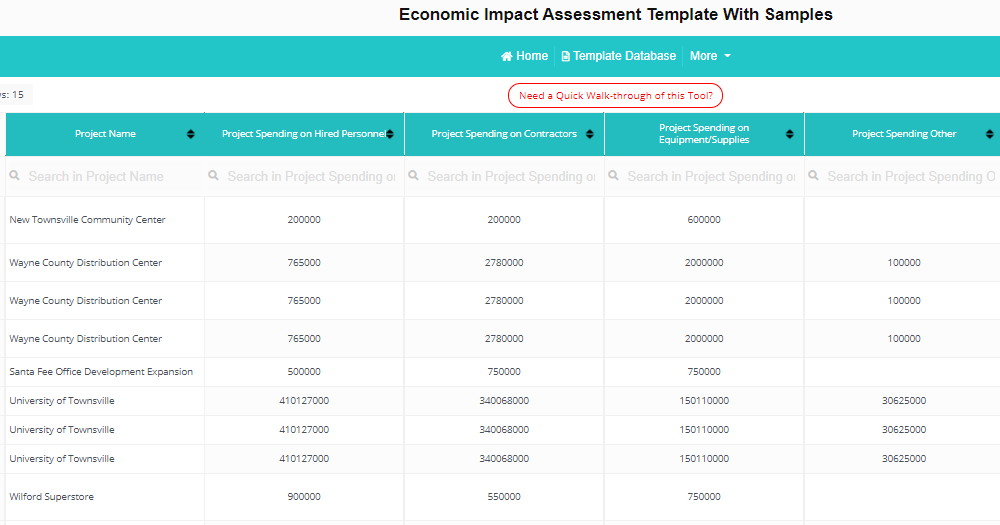
Example of Real-Time Analytics Dashboard in AGS Toolkit
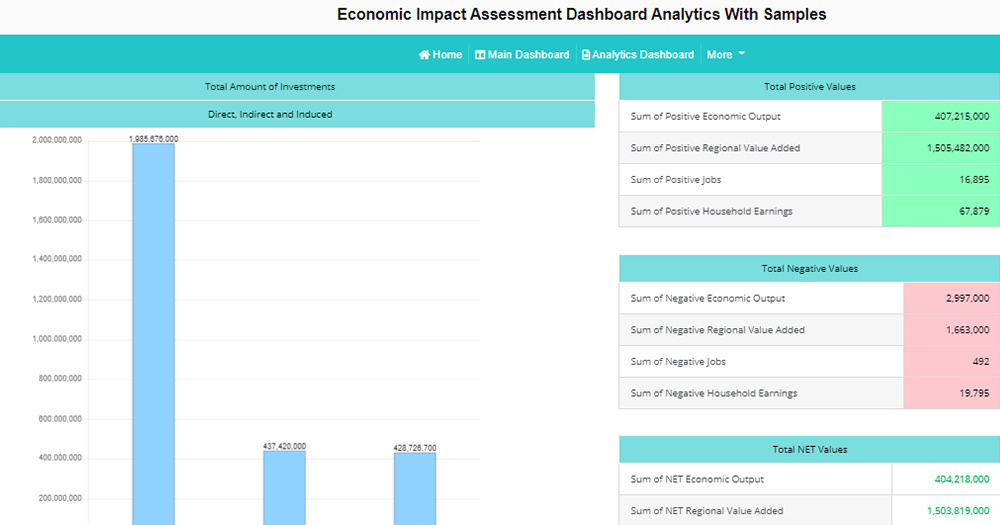
Learn More About AGS’ Economic Impact Assessment Tool
Step 5: Present Your Economic Impact Study to Stakeholders
Finally, you’ll put together the findings of your economic impacts study into a report for stakeholders. You’ll want to use graphs and charts to help express the facts and figures comprehensively.
This is where having the right economic impact assessment template can really make a difference. If you’ve chosen one that is just a document without automated analytics, you’ll be spending much more time creating charts yourself by hand.
Some economic impacts studies will include recommendations at the end based upon the data, while some will not. Instead, they will leave the decision up to stakeholders as to how they want to proceed based upon the data.
What’s the Best Economic Impact Assessment Template?
There is no standard economic impact assessment template to use for every project because these vary widely according to the type of project or event for which the study is being conducted.
Formatting of the report itself will be depending upon your pre-determined project scope and stakeholder expectations.
The best economic impact assessment template to use is one that can help you “crunch the numbers” and that gives you automated analytics and calculations based upon your data. These reports can then be brought into your economic impact study report.
One of the most flexible tools to use that includes real-time analytics is AGS’ Economic Impact Assessment Toolkit.
Benefits include:
- Input economic factors and see reporting instantly
- Ability to upload your data from a spreadsheet
- Database columns that capture a wide variety of project impact data
- Multiple calculations are done for you, improving accuracy and saving time
- Collaborate with others and share reporting with stakeholders online
- and More!
AGS Economic Impact Assessment Template Database
Try out the AGS Impact Assessment Tool at no risk for 30-days.
Conclusion | Guide to Assessing Economic Impacts for a Project
When a project, program, event, or policy is going to have an economic impact on a group, industry, or region, it’s important to do an economic impact analysis to determine the scope of that impact in several areas, including job growth, direct revenue, and more.
An economic impact study helps decision-makers understand the viability of a project as well as informs stakeholders as to the type of economic impacts that can be expected. It can also confirm projected expectations with hard figures.
When conducting an economic impact assessment, it’s important to use a good template or software tool that allows you to enter data and then chart reports and analytics to share with key stakeholders.
We hope this guide on economic impacts and how to assess them has been helpful and will serve as a roadmap for how to structure and conduct an economic impact study for a project, program, event, or policy change in the future.
Economic Impact Analysis FAQ
What is the meaning of economic impact?
The economic impact is the financial effect that an event, program, project, or policy has on an entity. That entity could be a person, a neighborhood, a city, an industry, or an entire country.
What is an economic analysis?
An economic analysis, also called an economic assessment, is a study of the impact on the economy for any type of project, event, program, or policy change.
You should include both the positive and negative economic impacts, not just the positive ones, so you end up with a realistic overall economic impact analysis.
There are typically three key types of economic impacts being analyzed:
• Direct Impacts
• Indirect Impacts
• Induced Impacts
How do you measure the economic impact of a project?
Part of how you define economic impact is to understand what factors of financial impacts you’re going to be analyzing. You’ll want to be sure that any economic impact assessment template you use accounts for four key measurement areas.
These measurement areas are:
• Economic output
• Regional value added
• Jobs
• Household earnings
How do you write an economic impact statement?
An economic impact statement should be a brief summary of your economic impact analysis. It can be included at the beginning of an economic assessment report and will allow stakeholders to read the key takeaways from the assessment.
You’ll want to include the following in an economic impact statement:
• Who is being impacted (region, groups, etc.)
• Results of economic impact study as to the financial benefits or drawbacks to economic output, regional value added, jobs, and household earnings.
• Any key points that you feel should be noted about the assessment.
• Parameters and scope of the economic assessment (the area that it covers, baseline year used for economic calculations, etc.)
Note: Content on OCM Solution's ocmsolution.com website is protected by copyright. Should you have any questions or comments regarding this OCM Solution page, please reach out to Ogbe Airiodion (Change Management Lead) or the OCM Solutions Team today. OCM Solution was previously known as Airiodion Global Services (AGS).
Images: Microsoft 365 Clip Art Image(s) (Bing images licensed under the Creative Commons license system.), https://pixabay.com/photos/application-request-ipad-tablet-1883453/

